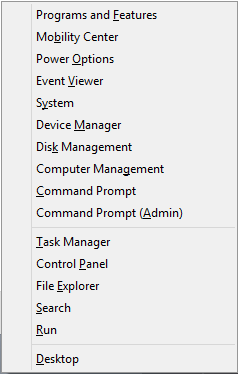-
-
products
-
resources
-
support
-
company
-
Using the Quick Access Menu in Windows 8
By Steve Horton March 08, 2013expert menu, power user menu, quick access menu, windows 8No CommentsWhat’s the Quick Access Menu in Windows 8, and what does it do?
In older versions of Windows, desktop users were generally fairly pleased with the Start Menu. You’d click the icon and you’d be able to select programs, Control Panel, run Searches — without taking up your entire screen, like Windows 8 does. If you’d like to return to doing things the old-fashioned way, then you can use Windows 8’s “Expert Menu”, also known as the “Quick Access Menu” and “Power User Menu”. I’m going to explain its functions.
First, move your mouse to the bottom-left corner of your screen and right-click, or press Windows Key + X. You’ll see a list of menu options appear.

The Quick Access Menu
From here, I’ll tell you what each of these Quick Access Menu options does.
- Programs and Features: browse through a list of your computer’s installed applications
- Network Connections: configure your computer’s network settings, connect to another network, or create one yourself
- Power Options: on laptops, activate a “Power Saver Mode” and modify other options related to your computer’s power, like screen brightness
- Event Viewer: see what programs were executed by who and when, as well as what system settings were modified
- System: view your operating system version, your Windows rating, your processor, your RAM, your OS type (32 or 64-bit), your computer’s name, and your product ID
- Device Manager: view, edit, delete and upgrade device drivers in or connected to your machine
- Disk Management: create partitions, delete them, merge them, shrink them, and modify any other disks connected to your computer
- Computer Management: view/enable Task Scheduler, Event Viewer, Shared Folders, Local Users and Groups, Performance, and Device Manager
- Command Prompt: access the command prompt, which will allow you to run specialized commands such as chkdsk and sfc /scannow
- Command Prompt (Admin): like above, but with elevated privileges
- Task Manager: view currently running applications, processes and services, as well as performance charts, networking diagrams, and descriptions of users currently logged in
- Control Panel: adjust Security, Network, Hardware, Account and Personalization options, as well as uninstall programs and modify Ease of Access options
- Windows Explorer: search, organize, rename, delete, and access the files strewn across your flash drive, hard drive, and other storage media connected to your computer
- Run: choose a program to execute
- Desktop: view your Desktop
Feel free to use this feature to restore the classic Start functionality you know and love — plus a bunch of shortcuts to options that technicians and repairmen will appreciate.
It is called the Expert Menu for a reason, after all.
Was this post helpful?YesNoFree Driver Updates
Update your drivers in less than 2 minutes to enjoy better PC performance - Free.
Free Driver Updates
Update your drivers in less than 2 minutes to enjoy better
PC performance - Free.
Didn't find your answer?Ask a question to our community of experts from around the world and receive an answer in no time at all.most relevant recent articles Pin It on Pinterest